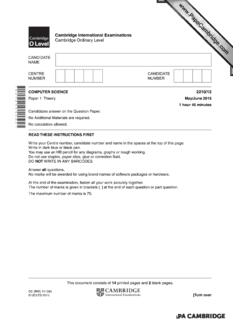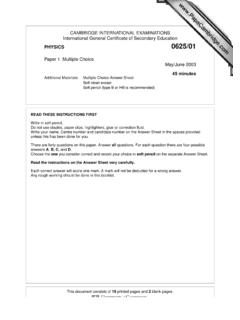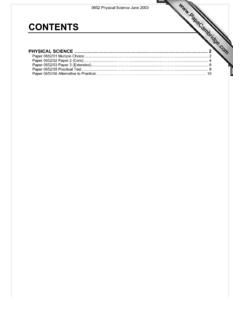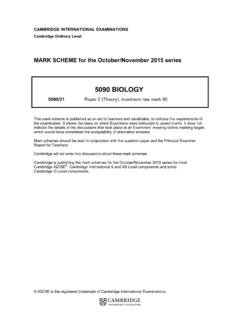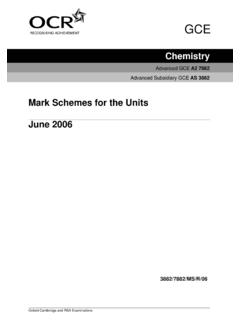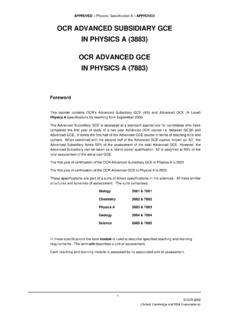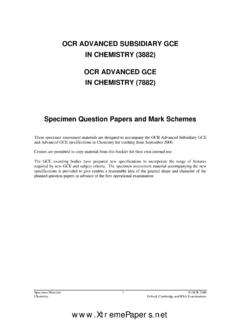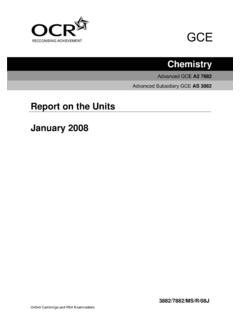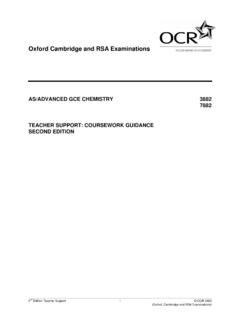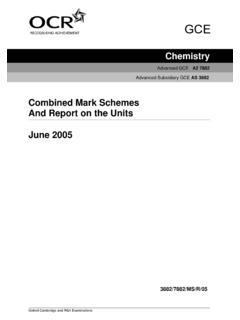Transcription of Mark Schemes for the Units - …
1 Oxford Cambridge and RSA Examinations GCEC hemistry advanced GCE A2 7882 advanced Subsidiary GCE AS 3882 Mark Schemes for the Units June 2007 3882/ 7882 /MS/ Oxford Cambridge and RSA Examinations OCR (Oxford Cambridge and RSA Examinations) is a unitary awarding body, established by the University of Cambridge Local Examinations Syndicate and the RSA Examinations Board in January 1998. OCR provides a full range of GCSE, A level, GNVQ, Key Skills and other qualifications for schools and colleges in the United Kingdom, including those previously provided by MEG and OCEAC. It is also responsible for developing new syllabuses to meet national requirements and the needs of students and teachers.
2 This mark scheme is published as an aid to teachers and students, to indicate the requirements of the examination. It shows the basis on which marks were awarded by Examiners. It does not indicate the details of the discussions which took place at an Examiners meeting before marking commenced. All Examiners are instructed that alternative correct answers and unexpected approaches in candidates scripts must be given marks that fairly reflect the relevant knowledge and skills demonstrated. Mark Schemes should be read in conjunction with the published question papers and the Report on the Examination. OCR will not enter into any discussion or correspondence in connection with this mark scheme. OCR 2007 Any enquiries about publications should be addressed to: OCR Publications PO Box 5050 Annesley NOTTINGHAM NG15 0DL Telephone: 0870 870 6622 Facsimile: 0870 870 6621 E-mail: advanced GCE Chemistry ( 7882 ) advanced Subsidiary GCE Chemistry (3882) MARK SCHEME FOR THE Units Unit Content Page 2811 Foundation Chemistry 1 2812 Chains and Rings 9 2813/01 How Far?
3 How Fast? / Experimental Skills 1 Written Paper 15 2813/03 How Far? How Fast? / Experimental Skills 1 Practical Examination 21 2814 Chain, Rings and Spectroscopy 29 2815/01 Trend and Patterns 45 2815/02 Biochemistry 49 2815/03 Environmental Chemistry 57 2815/04 Methods of Analysis and Detection 63 2815/05 Gases, Liquids and Solids 69 2815/06 Transition Elements 75 2816/01 Unifying Concepts in Chemistry/Experimental Skills 2 Written Paper 83 2816/03 Unifying Concepts in Chemistry/Experimental Skills 2 Practical Examination 93 * Grade Thresholds 100 1 Mark Scheme 2811 June 2007 Mark Scheme June 2007 2 ADVICE TO EXAMINERS ON THE ANNOTATION OF SCRIPTS 1.
4 Please ensure that you use the final version of the Mark Scheme. You are advised to destroy all draft versions. 2. Please mark all post-standardisation scripts in red ink. A tick (9) should be used for each answer judged worthy of a mark. Ticks should be placed as close as possible to the point in the answer where the mark has been awarded. The number of ticks should be the same as the number of marks awarded. If two (or more) responses are required for one mark, use only one tick. Half marks ( ) should never be used. 3. The following annotations may be used when marking. No comments should be written on scripts unless they relate directly to the mark scheme. Remember that scripts may be returned to Centres. x = incorrect response (errors may also be underlined) ^ = omission mark bod = benefit of the doubt (where professional judgement has been used) ecf = error carried forward (in consequential marking) con = contradiction (in cases where candidates contradict themselves in the same response) sf = error in the number of significant figures 4.
5 The marks awarded for each part question should be indicated in the margin provided on the right hand side of the page. The mark total for each question should be ringed at the end of the question, on the right hand side. These totals should be added up to give the final total on the front of the paper. 5. In cases where candidates are required to give a specific number of answers, ( give three reasons ), mark the first answer(s) given up to the total number required. Strike through the remainder. In specific cases where this rule cannot be applied, the exact procedure to be used is given in the mark scheme. 6. Correct answers to calculations should gain full credit even if no working is shown, unless otherwise indicated in the mark scheme.
6 (An instruction on the paper to Show your working is to help candidates, who may then gain partial credit even if their final answer is not correct.) 7. Strike through all blank spaces and/or pages in order to give a clear indication that the whole of the script has been considered. 8. An element of professional judgement is required in the marking of any written paper, and candidates may not use the exact words that appear in the mark scheme. If the science is correct and answers the question, then the mark(s) should normally be credited. If you are in doubt about the validity of any answer, contact your Team Leader/Principal Examiner for guidance. Mark Scheme June 2007 3 Abbreviations, annotations and conventions used in the Mark Scheme / = alternative and acceptable answers for the same marking point.
7 = separates marking points NOT = answers which are not worthy of credit ( ) = words which are not essential to gain credit = (underlining) key words which must be used to gain credit ecf = error carried forward AW = alternative wording ora = or reverse argument Question Expected answers Marks 1 (a) 1, 2 or 3 p orbitals are OK 9 9 [2] (b) d orbital 2 9 p sub-shell 6 9 3rd shell 18 9 [3] (c) (i) (ii) 2s and 2p labels 9 Ignore any superscripted numbers. 8 electrons in correct levels with arrows correctly shown 9 [2] (d) (i) (ii) (iii) Energy change when each atom in 1 mole 9 of gaseous atoms 9 loses an electron 9 (to form 1 mole of gaseous 1+ ions).
8 O2+(g) O3+(g) + e 99 1 mark for correct species; 1 mark for state symbols No charge required on electron. Ignore (g) on e Large difference between 6th and 7th IEs 9 marking a different shell (closer to nucleus) 9 allow inner shells /new shell/full shell/first shell marking points independent. not sub-shell or orbital [3] [2] [2] Total: 14 Mark Scheme June 2007 4 Abbreviations, annotations and conventions used in the Mark Scheme / = alternative and acceptable answers for the same marking point ; = separates marking points NOT = answers which are not worthy of credit ( ) = words which are not essential to gain credit = (underlining) key words which must be used to gain credit ecf = error carried forward AW = alternative wording ora = or reverse argument Question Expected answers Marks 2 (a) (i) (ii) (iii) mass = x = g 9 moles H2 = 9 volume H2 = x 24 = dm3 9 ecf from calculated moles H2 mol in cm3 concentration = x 20 = mol dm 3 9 [1] [2] [1] (b) ONa+2 Na+ Also accept Na with full shell as long as it contains x s (as in example above)
9 Ignore any inner shells correct dot and cross 9 correct charges 9 [2] (c) (i) (ii) (iii) 2Na + O2 Na2O2 9 Na2O2 + 2H2O H2O2 + 2 NaOH 9 correct covalent bonds shown 9 electron count (14) for rest of molecule correct 9 [1] [1] [2] Total: 10 Mark Scheme June 2007 5 Abbreviations, annotations and conventions used in the Mark Scheme / = alternative and acceptable answers for the same marking point ; = separates marking points NOT = answers which are not worthy of credit ( ) = words which are not essential to gain credit = (underlining) key words which must be used to gain credit ecf = error carried forward AW = alternative wording ora = or reverse argument Question Expected answers Marks 3 (a) add AgNO3 /add Ag+ 9 ignore ammonia white (precipitate)/goes white/precipitate that dissolves in dilute NH3(aq) 9 Ag+ + Cl AgCl 9 (ignore state symbols) [3] (b) add NaOH 9 Cl2 + 2 NaOH NaCl + NaClO + H2O9 or partial or completely ionic equation.
10 Cl2 + 2 NaOH 2Na+ + ClO + Cl + H2O/ Cl2 + 2OH ClO + Cl + H2O9 [2] (c) number of electrons /electron shells increases down group 9 van der Waals forces /induced dipole dipole interactions 9 forces greater Cl2 < Br2 < I2 9 [3] (d) (i) (ii) (trigonal) pyramidal 9 electron pairs repel/bonds repel /electron pairs get as far apart as possible 9 lone pairs repel more/forces them closer 9 4 electron pairs surround central atom or N /diagram with 3 bonds and a lone pair 9 [1] [3] Total: 12 Mark Scheme June 2007 6 Abbreviations, annotations and conventions used in the Mark Scheme / = alternative and acceptable answers for the same marking point ; = separates marking points NOT = answers which are not worthy of credit ( ) = words which are not essential to gain credit = (underlining) key words which must be used to gain credit ecf = error carried forward AW = alternative wording ora = or reverse argument Question Expected answers Marks 4 (a) (i) (ii) (iii) (iv) They have different numbers of protons/ Ba has one more proton/Ba has 56 p+.
